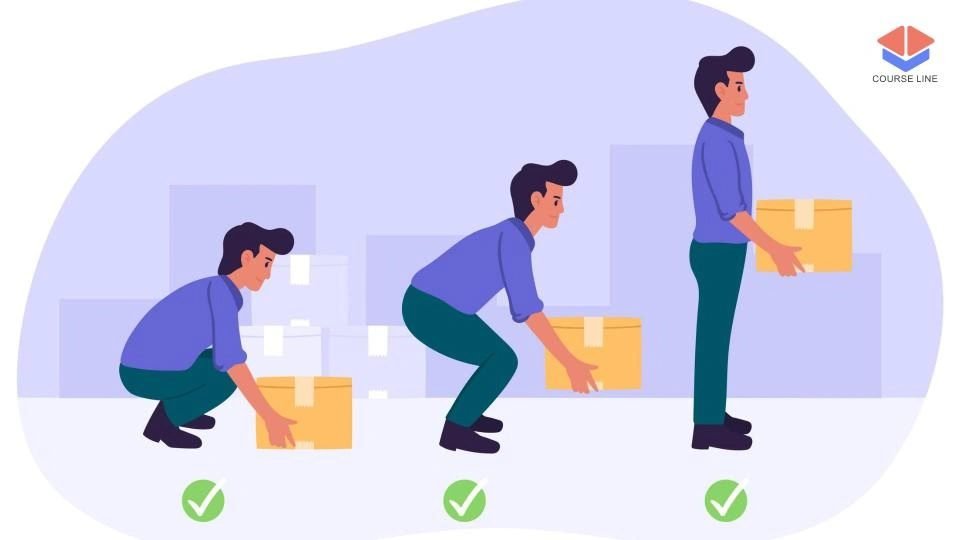Course Features
Price
Study Method
Online | Self-paced
Course Format
Reading Material - PDF, article
Duration
2 hours, 5 minutes
Qualification
No formal qualification
Certificate
At completion
Additional info
Coming soon
- Share
Overview
The "Manual Handling Curriculum Breakdown" course offers a comprehensive approach to manual handling safety, focusing on key aspects of preventing injuries and ensuring a safe working environment. Module 1 introduces learners to the essential legislation and guidance surrounding manual handling, ensuring that individuals understand their legal obligations and the standards that need to be followed in the workplace. This module sets the foundation for further study, emphasizing the importance of safety in manual handling tasks.
Module 2 covers manual handling hazards and injuries, providing insight into the common risks associated with manual tasks, such as lifting, carrying, pushing, or pulling. Understanding these hazards is crucial in identifying potential injury risks early on. In Module 3, learners will focus on injury prevention and the importance of reporting accidents to maintain safety in the workplace. This section empowers participants to recognize early signs of injury and understand the necessary actions to prevent them from escalating.
Module 4 introduces manual handling risk assessments, equipping learners with the skills to identify and assess risks in their environment. This module teaches how to systematically evaluate tasks to ensure safe manual handling practices. Module 5 discusses controlling and reducing risks through practical strategies, including ergonomics and safe systems of work. The final module, Safe Lifting Techniques, emphasizes proper lifting methods to avoid strain and injury, teaching learners how to lift objects safely and efficiently.
This course is ideal for individuals working in environments where manual handling tasks are common. By the end of the course, learners will be equipped to assess risks, implement safety protocols, and perform manual handling tasks with confidence and minimal risk of injury.
Who is this course for?
The "Manual Handling Curriculum Breakdown" course offers a comprehensive approach to manual handling safety, focusing on key aspects of preventing injuries and ensuring a safe working environment. Module 1 introduces learners to the essential legislation and guidance surrounding manual handling, ensuring that individuals understand their legal obligations and the standards that need to be followed in the workplace. This module sets the foundation for further study, emphasizing the importance of safety in manual handling tasks.
Module 2 covers manual handling hazards and injuries, providing insight into the common risks associated with manual tasks, such as lifting, carrying, pushing, or pulling. Understanding these hazards is crucial in identifying potential injury risks early on. In Module 3, learners will focus on injury prevention and the importance of reporting accidents to maintain safety in the workplace. This section empowers participants to recognize early signs of injury and understand the necessary actions to prevent them from escalating.
Module 4 introduces manual handling risk assessments, equipping learners with the skills to identify and assess risks in their environment. This module teaches how to systematically evaluate tasks to ensure safe manual handling practices. Module 5 discusses controlling and reducing risks through practical strategies, including ergonomics and safe systems of work. The final module, Safe Lifting Techniques, emphasizes proper lifting methods to avoid strain and injury, teaching learners how to lift objects safely and efficiently.
This course is ideal for individuals working in environments where manual handling tasks are common. By the end of the course, learners will be equipped to assess risks, implement safety protocols, and perform manual handling tasks with confidence and minimal risk of injury.
Requirements
The "Manual Handling Curriculum Breakdown" course offers a comprehensive approach to manual handling safety, focusing on key aspects of preventing injuries and ensuring a safe working environment. Module 1 introduces learners to the essential legislation and guidance surrounding manual handling, ensuring that individuals understand their legal obligations and the standards that need to be followed in the workplace. This module sets the foundation for further study, emphasizing the importance of safety in manual handling tasks.
Module 2 covers manual handling hazards and injuries, providing insight into the common risks associated with manual tasks, such as lifting, carrying, pushing, or pulling. Understanding these hazards is crucial in identifying potential injury risks early on. In Module 3, learners will focus on injury prevention and the importance of reporting accidents to maintain safety in the workplace. This section empowers participants to recognize early signs of injury and understand the necessary actions to prevent them from escalating.
Module 4 introduces manual handling risk assessments, equipping learners with the skills to identify and assess risks in their environment. This module teaches how to systematically evaluate tasks to ensure safe manual handling practices. Module 5 discusses controlling and reducing risks through practical strategies, including ergonomics and safe systems of work. The final module, Safe Lifting Techniques, emphasizes proper lifting methods to avoid strain and injury, teaching learners how to lift objects safely and efficiently.
This course is ideal for individuals working in environments where manual handling tasks are common. By the end of the course, learners will be equipped to assess risks, implement safety protocols, and perform manual handling tasks with confidence and minimal risk of injury.
Career path
The "Manual Handling Curriculum Breakdown" course offers a comprehensive approach to manual handling safety, focusing on key aspects of preventing injuries and ensuring a safe working environment. Module 1 introduces learners to the essential legislation and guidance surrounding manual handling, ensuring that individuals understand their legal obligations and the standards that need to be followed in the workplace. This module sets the foundation for further study, emphasizing the importance of safety in manual handling tasks.
Module 2 covers manual handling hazards and injuries, providing insight into the common risks associated with manual tasks, such as lifting, carrying, pushing, or pulling. Understanding these hazards is crucial in identifying potential injury risks early on. In Module 3, learners will focus on injury prevention and the importance of reporting accidents to maintain safety in the workplace. This section empowers participants to recognize early signs of injury and understand the necessary actions to prevent them from escalating.
Module 4 introduces manual handling risk assessments, equipping learners with the skills to identify and assess risks in their environment. This module teaches how to systematically evaluate tasks to ensure safe manual handling practices. Module 5 discusses controlling and reducing risks through practical strategies, including ergonomics and safe systems of work. The final module, Safe Lifting Techniques, emphasizes proper lifting methods to avoid strain and injury, teaching learners how to lift objects safely and efficiently.
This course is ideal for individuals working in environments where manual handling tasks are common. By the end of the course, learners will be equipped to assess risks, implement safety protocols, and perform manual handling tasks with confidence and minimal risk of injury.
-
- Introduction, Legislation and Guidance 00:10:00
-
- Manual Handling Hazards and Injuries 00:10:00
- Manual Handling Injuries Prevention and Reporting Accidents 00:10:00
- Controlling and Reducing the Risks 00:10:00
- Exam of Manual Handling 00:50:00

Is this certificate recognized?
Yes, our premium certificate and transcript are widely recognized and accepted by embassies worldwide, particularly by the UK embassy. This adds credibility to your qualification and enhances its value for professional and academic purposes.
I am a beginner. Is this course suitable for me?
Yes, this course is designed for learners of all levels, including beginners. The content is structured to provide step-by-step guidance, ensuring that even those with no prior experience can follow along and gain valuable knowledge.
I am a professional. Is this course suitable for me?
Yes, professionals will also benefit from this course. It covers advanced concepts, practical applications, and industry insights that can help enhance existing skills and knowledge. Whether you are looking to refine your expertise or expand your qualifications, this course provides valuable learning.
Does this course have an expiry date?
No, you have lifetime access to the course. Once enrolled, you can revisit the materials at any time as long as the course remains available. Additionally, we regularly update our content to ensure it stays relevant and up to date.
How do I claim my free certificate?
I trust you’re in good health. Your free certificate can be located in the Achievement section. The option to purchase a CPD certificate is available but entirely optional, and you may choose to skip it. Please be aware that it’s crucial to click the “Complete” button to ensure the certificate is generated, as this process is entirely automated.
Does this course have assessments and assignments?
Yes, the course includes both assessments and assignments. Your final marks will be determined by a combination of 20% from assignments and 80% from assessments. These evaluations are designed to test your understanding and ensure you have grasped the key concepts effectively.
Is this course accredited?
We are a recognized course provider with CPD, UKRLP, and AOHT membership. The logos of these accreditation bodies will be featured on your premium certificate and transcript, ensuring credibility and professional recognition.
Will I receive a certificate upon completion?
Yes, you will receive a free digital certificate automatically once you complete the course. If you would like a premium CPD-accredited certificate, either in digital or physical format, you can upgrade for a small fee.
Course Features
Price
Study Method
Online | Self-paced
Course Format
Reading Material - PDF, article
Duration
2 hours, 5 minutes
Qualification
No formal qualification
Certificate
At completion
Additional info
Coming soon
- Share
YouTube Video SEO Masterclass: Boost Views, Engagement & Subscribers
Course Line237£490.00Original price was: £490.00.£14.99Current price is: £14.99.Watsu and Aquatic Bodywork Level 3 Advanced Diploma
Course Line238£490.00Original price was: £490.00.£14.99Current price is: £14.99.






Very good, and questions were clear and straight forward